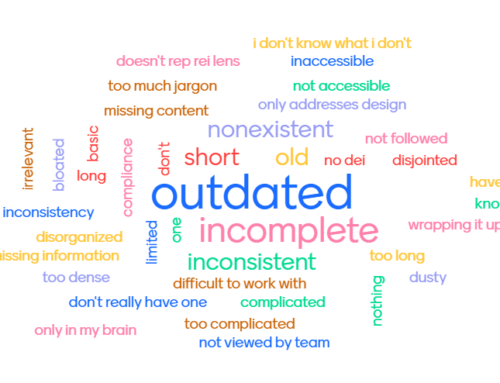
Laurel Dykema
Guest Post by Laurel Dykema
When I started my nonprofit writing career, I was a new college graduate with a lot to learn about nonprofit communications.
During those first years, I had a great mentor who taught me the ropes of nonprofit communications, but not everyone is so lucky—so I decided to compile some of the best insights I’ve gained over the course of my career for you. I think this advice will be especially helpful for new nonprofit writers, but perhaps even seasoned nonprofit professionals will find something new to consider!
Here are my top 10 pieces of advice for new nonprofit writers:
#1 Learn to Handle Criticism
Receiving negative feedback on something you wrote doesn’t mean you’re a bad writer.
In fact, handling criticism is so much a part of our work as nonprofit writers, it really should be listed in our job descriptions! You must be able to receive negative feedback graciously, ask good clarifying questions, and adjust content accordingly if you want to succeed as a nonprofit writer.
#2 Repurpose Great Content
This might be my favorite piece of advice because it’s so practical!
If you have great content, put it in as many places as you can so it’s visible to more people. For example, you can turn a Facebook post that performed well into a fundraising email. Use a fantastic photo in your print newsletter, on your website, and on Instagram.
Use your imagination and recycle your nonprofit’s best content!
#3 Don’t Fill Your Whole Workday with Writing
When you’re just starting your nonprofit writing career, spending every minute of your workday writing might *seem* like the best use of your time. But it can also lead to a lack of creativity! Brains need breaks. Intentionally schedule times during your workday when you take a break from writing.
Some productive ideas for your non-writing time:
- Ask your interns, “What surprised you most about the population our nonprofit works with?” or “Which one of our programs is your favorite and why?”
- Browse the content other nonprofits are posting on social media. Make a note of posts that are performing well for them and brainstorm how you can create similar posts for your nonprofit’s social media pages.
- Google the region your nonprofit works in and read up on the latest news. Bookmark relevant articles, then think about how you can share that information with your nonprofit’s supporters. Would it be best to directly share the article to your social media page? Or could you reference a relevant news story in an upcoming email? (Don’t forget to cite your sources!)
- Attend a webinar for a skill you’d like to hone. (Nonprofit Marketing Guide has great ones!)
- Chat with coworkers who regularly interact with donors. Ask them, “What story has really resonated with donors lately?” or “What questions are donors asking?”
#4 Save Positive Feedback in a “Happy Folder”
When my college professors loved a paper I wrote, they often handwrote positive comments in the margins. I saved those papers in a yellow folder I nicknamed “The Happy Folder.” Whenever I was struggling in a class or having a hard day in college, I pulled out the folder. Flipping through all the positive comments gave me a boost and encouraged me to keep going!
I kept this habit when I began my nonprofit writing career. I created an email “Happy Folder” where I stored meaningful positive feedback from my manager, coworkers, and even donors!
Make your own “Happy Folder” in a cloud-based storage service or in your email. Save positive feedback as well as information about successful projects in your “Happy Folder” (don’t forget to include numbers!). This is a great place to go when you need a little encouragement. It can also be a great resource to pull from for your performance reviews or wage increase discussions.
#5 Bend (Some) Grammar Rules
Hear me out. I’m not suggesting you start using incorrect spellings or unclear sentences.
However, you can start a sentence with “and,” “but,” or “or.” Also feel free to use ellipses (…) and em dashes (—). We’re not going for the same formal tone you might have used in your college papers. Bending some grammar rules can make your writing seem more conversational, relatable, and personable.
Shhhhh … your English 101 college professor never has to know!
#6 Set up Google Alerts
Set up Google Alerts to automatically get the latest news from the location(s) where your nonprofit works.
Here are some practical ways you can use the articles you get through Google Alerts:
- Post relevant articles directly on your nonprofit’s social media.
- Reference the latest news from that region in your next mass email to donors.
- Write an article explaining how something in the news (for example, a flood or hurricane) will affect the population your nonprofit assists. Even better if you are able to explain how your nonprofit can help. Then, post it on your nonprofit’s website or blog.
Referencing the latest news helps establish your nonprofit as a leader for information about that region and the population you work with.
#7 Be a Spy
*dramatic spy music* “Duh-duh, dee-duh-duuuun!”
On social media platforms, spy on (ahem … follow) other nonprofit organizations to see which posts are highly engaging to their followers. Use the information you gather to shape your nonprofit’s posts and social media strategies.
#8 Make Your Donor the Hero
This one is really simple but powerful! Whenever possible, point to your donors’ impact instead of your nonprofit’s impact. When you write a story, think about how you can focus less on your organization and make your donors the heroes—because they are!
One easy way to do this: Replace mentions of your nonprofit in your impact story with the word “you.”
#9 Bring Stories to Life Using Senses
This tip requires you to use your imagination (and maybe some research, too). Including descriptions of sight, smell, sound, touch, or taste is a great way to bring your nonprofit’s stories to life.
For example, if I was telling a story about Ganesha, a woman who lives near train tracks in India, I might write, “Thick smoke pours from smokestacks as trains roll past near Ganesha’s home. But after 9 years of living next to the train tracks, Ganesha is used to the smell.” Another option: “The screeching whistle of the first train of the day wakes Ganesha early each morning.”
#10 Ask Questions
No matter how long you’ve been working at your nonprofit, there are always new things to learn.
Know a coworker who meets face-to-face or talks on the phone with donors? Ask them what inspires those donors to give or what kinds of questions donors have. Ask the intern what they were surprised to learn about your nonprofit. Ask your volunteers why they volunteer. The answers to these questions can inspire you to create even more relevant and compelling content.
Fellow experienced nonprofit communications professionals, what would you add to this list?






